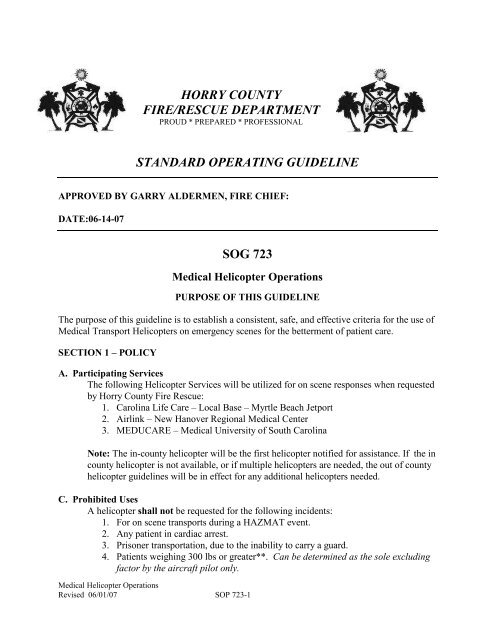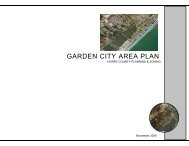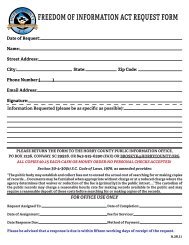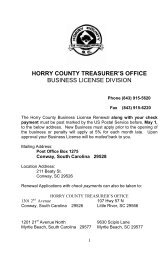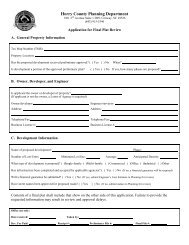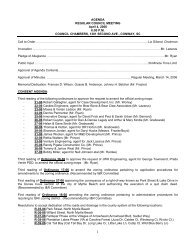horry county fire/rescue department standard operating guideline ...
horry county fire/rescue department standard operating guideline ...
horry county fire/rescue department standard operating guideline ...
- No tags were found...
You also want an ePaper? Increase the reach of your titles
YUMPU automatically turns print PDFs into web optimized ePapers that Google loves.
HORRY COUNTYFIRE/RESCUE DEPARTMENTPROUD * PREPARED * PROFESSIONALSTANDARD OPERATING GUIDELINEAPPROVED BY GARRY ALDERMEN, FIRE CHIEF:DATE:06-14-07SOG 723Medical Helicopter OperationsPURPOSE OF THIS GUIDELINEThe purpose of this <strong>guideline</strong> is to establish a consistent, safe, and effective criteria for the use ofMedical Transport Helicopters on emergency scenes for the betterment of patient care.SECTION 1 – POLICYA. Participating ServicesThe following Helicopter Services will be utilized for on scene responses when requestedby Horry County Fire Rescue:1. Carolina Life Care – Local Base – Myrtle Beach Jetport2. Airlink – New Hanover Regional Medical Center3. MEDUCARE – Medical University of South CarolinaNote: The in-<strong>county</strong> helicopter will be the first helicopter notified for assistance. If the in<strong>county</strong> helicopter is not available, or if multiple helicopters are needed, the out of <strong>county</strong>helicopter <strong>guideline</strong>s will be in effect for any additional helicopters needed.C. Prohibited UsesA helicopter shall not be requested for the following incidents:1. For on scene transports during a HAZMAT event.2. Any patient in cardiac arrest.3. Prisoner transportation, due to the inability to carry a guard.4. Patients weighing 300 lbs or greater**. Can be determined as the sole excludingfactor by the aircraft pilot only.Medical Helicopter OperationsRevised 06/01/07 SOP 723-1
SECTION 2 - CONSIDERATIONSA. Helicopter Launch AuthorizationThe authorization to launch a helicopter will rest with the primary responding Paramedic,the on-duty Battalion Chief or the on-duty Shift Medical Officer.1. By dispatch protocol, the in <strong>county</strong> helicopter will be “toned” to stand-by with theinitial responding units when the report made to the E911 center indicates:(i) A vehicle accident with entrapment(ii) A pedestrian struck by vehicle(iii) An accident involving a motorcycle(iv) A patient has fallen greater than ten feet*** If the in <strong>county</strong> helicopter is listed as “out of service” or “out of <strong>county</strong>”within the CAD system, no helicopter will be toned on these incidents.Responding personnel who believe that the call will meet the criteria for an out of<strong>county</strong> helicopter response should request one as soon as possible. ***2. Helicopter launch may be requested if information is obtained that the patient hassignificant injuries meeting flight criteria and that use of a medical helicopter willnot delay treatment and negatively impact the patient’s condition. Incircumstances not meeting the criteria for the helicopter being toned with initialunits a helicopter may be requested by responding personnel if the informationgiven to the responders indicates the need for the use of a medical helicopter.3. When a helicopter is placed on stand-by on initial tone out or requested byresponding personnel, dispatch will either be contacted via radio by the in <strong>county</strong>crew to indicate that the flight crew acknowledges the stand-by or call the out of<strong>county</strong> helicopter service and ask on availability. If it is available, it will be placedinto stand-by. In both cases the dispatch center will give the coordinates for thescene or requested LZ to the helicopter service dispatcher if they are availablefrom the CAD. They will then relay to the requesting unit the helicopteravailability status. The requesting unit will advise dispatch on the need to launchor cancel the helicopter as soon as possible.4. Any time a helicopter is requested, both the Shift Medical Officer and theappropriate Battalion Chief must also be notified.Note: MEDUCARE will automatically launch as soon as they are placed on Standby.This is due to the extended flight time from Charleston. Carolina Life Care andAIRLINK (Wilmington) will not launch until requested to do so. If the helicopterservice decides to auto launch without being requested to do so by our agency, theinformation in this policy must still be strictly adhered to. Patient flight criteriashould still be followed.Medical Helicopter OperationsRevised 06/01/07 SOP 723-2
B. Patient CriteriaThe following patient condition <strong>guideline</strong>s will be adhered to, and subject to review forQuality Assurance/Quality Improvement.*** It is recognized that the need for the use of a medical helicopter to transport patients tomedical facilities that are capable of providing the highest levels of care is an importantaspect of treating the critically ill or injured patient appropriately. However, those patientswho present to be unstable to a degree that survival through-out the expected flight time isunlikely should be considered for transport to a local facility despite the need for a TraumaCenter of higher level of care. The judgment to use a medical helicopter on the highlyunstable patient can be weighed using the input of on-scene flight crewmembers, On-lineMedical Control, or fellow ALS providers on the scene.No patient’s transport to a receiving Trauma Center, whether within the <strong>county</strong> oroutside of the <strong>county</strong>, should be significantly delayed to the point of negatively impactingthe patient to wait for the arrival of a medical helicopter. If ground transport of the patientto a local Trauma Center would be appreciably quicker than the flight time for the arrival ofthe helicopter on-scene, the patient should be transported via ground transport to a localTrauma Center. ***In County Helicopter1. Trauma Patientsa. The patient will be classified as Priority Condition 2. This includes, but is notlimited to, patients that:• Have multi system trauma,• Are unresponsive,• Have a systolic BP of 90 mmHg or less,• Have a respiratory rate of 30 / min,• Patients with acute conditions that after consultation with a local receivingfacility you are directed to transport the patient out of the area using amedical helicopter.• Proximal amputations,• Any patient with a high mechanism of injury and that the reasons fortransporting by medical helicopter can be well justified. These situationsmust be well documented on the PCR for later review.b. All trauma patients will be properly secured to a Long Spine Board, withappropriate c-collar, straps and cervical stabilization device in place.2. Medical Patientsa. The patient will be classified as Priority Condition 2. They will have a conditionthat warrants immediate care at a specialized facility and due to currentoperational conditions a timely ground transport would be extensively delayed.Use of a medical transport helicopter under these conditions may be approved bythe on-duty Battalion Chief or Shift Medical Officer.Medical Helicopter OperationsRevised 06/01/07 SOP 723-3
3. Burn Patientsa. The patient will have burns that meet <strong>guideline</strong>s for admission to a recognizedburn center. This criteria includes:• Second degree burns > 10% Total Body Surface Area (TBSA),• Burns involving the face, hands, feet, genitalia, perineum, or major joints.• Circumferential burns of the extremities and/or chest.• Third degree burns in any age group.• Electrical burns, including lightning injury.• Chemical Burns – only if the patient can be completely decontaminatedand there is absolutely no possibility of contamination to the flight crew orthe aircraft.• Inhalation injury.• Burn Injury in patients with preexisting medical disorders that couldcomplicate management, prolong recovery, or affect mortality.• Burn injury in patients who will require special social, emotional, or longtermrehabilitative intervention.Out of County Helicopters1. Trauma Patientsa. The patient will be in a condition to which removal for transport is impossiblefor a time estimated to be 25 minutes or greater.b. The patient will be classified as Priority Condition 2. This includes, but is notlimited to, patients that:• have multi system trauma,• are unresponsive,• have a systolic BP of 90 mmHg or less,• have a respiratory rate of 30 / min,c. All trauma patients will be properly secured to a Long Spine Board, with C-Collar in place.2. Medical Patientsa. Due to the prolonged time to have an out of <strong>county</strong> helicopter fly in, medicalpatients will be transported by ground to the closest appropriate medical facility.3. Burn Patientsa. Due to the prolonged time to have an out of <strong>county</strong> helicopter fly in, burnpatients will be transported by ground to the closest appropriate trauma center.Medical Helicopter OperationsRevised 06/01/07 SOP 723-4
C. CommunicationThe following shall be followed when communicating with the helicopter:1. The LZ coordinator will be the only person to initiate and maintain contact withthe helicopter via radio. The below frequencies will be utilized to communicatewith the helicopter in the following order:a. 800 MHz – TAC 10 (Air Operations Channel)b. 800 MHz – SC TAC 1c. VHF - HCFR Talk Aroundd. VHF - Hospital frequencyNote: VHF frequencies are to be used only if the 800 system is down, or nocommunication is made with the incoming helicopter after numerous attempts.2. All information from the scene will be relayed to the helicopter through the LZcoordinator once radio contact has been made. Only the LZ coordinator isallowed to communicate on the designated frequency unless an imminent dangerto the flight crew is present that the LZ coordinator is unaware of and thecommunication is made for the purpose of aborting the helicopter’s landing.3. Once the helicopter is in sight, the LZ coordinator will attempt to establishcontact with the helicopter crew. The flight crew for the most part will not bemonitoring TAC 10 (or other designated air operations channel) until they are inclose proximity to the scene due to maintaining radio contact with their flightcontrol and air traffic control.4. All potential hazards (power lines, radio towers, trees, signs, and all groundobjects (i.e., small bushes etc.) will be relayed to the incoming helicopter by theLZ coordinator once contact with the helicopter has been established.5. The LZ coordinator will keep his/her radio on TAC 10 with the radio scan turnedoff. The radio is to be kept in a manner that will allow for expeditiouscommunications with the medical helicopter if needed.6. Once the helicopter has started it’s approach, radio silence will be observedunless a hazard is noticed, in which case the helicopter will be ordered toABORT.7. If unable to make contact with the incoming helicopter, their dispatch is to becontacted and information relayed through them.8. The LZ coordinator shall use “Horry County LZ” as his/her radio designationwhen communicating with all medical helicopters.9. The LZ coordinator will notify the appropriate dispatcher (TAC 1 or TAC 2)when the helicopter lands safely at the LZ and when the helicopter is in the airand departing the LZ. The helicopters destination hospital should be relayed todispatch at that time.10. If for any reason the LZ coordinator does feel comfortable that the helicoptercrew is aware of all potential hazards, the LZ coordinator should establishcontact with the helicopter crew and repeat all potential hazards. SAFETY OFTHE GROUND CREWS AND THAT OF THE HELICOPTER CREW IS THEMedical Helicopter OperationsRevised 06/01/07 SOP 723-5
LZ COORDINATORS NUMBER ONE PRIORITY and he/she should make allattempts to be free of all other distractions and responsibilities.11. Once the helicopter departs the LZ, the LZ coordinator will continue to monitorthe designated air operations channel for 10 minutes in case the helicopter needsto reestablish contact with the LZ coordinator.12. In the event that more than one medical helicopter is being utilized on the samescene and/or LZ, the coordinator should request dispatch to notify each flightservice that other medical helicopters are being used in the same area. The LZcoordinator should also relay this information to each helicopter whencommunication is established.13. Unless requested by the flight crew no detailed patient condition, vital signs orother information will be given over the radio to the medical helicopter. Theflight crew will obtain all needed information when they arrive on the scene.D. Relaying InformationWhen requesting a medical helicopter, the following patient information will be relayed tothe helicopter service via dispatch ASAP:1. LZ location with GPS Coordinates or the location of the incident2. The number of patients3. Estimated age and patient weight4. Type of accident5. The extent of injuries6. Any situation specific information about the patient’s size or injuries.E. Cancellation of the HelicopterIf it is determined that the helicopter is not needed after a launch has been initiated, thefollowing procedures will be performed:1. If the patient is capable of ground transport prior to the arrival of the Helicopter, theambulance crew WILL NOT significantly delay transport to await the arrival of thehelicopter.2. If the patient is freed and transport initiated prior to the arrival of the helicopter, thehelicopter can be diverted to the receiving hospital’s helipad. The receiving hospitalwill be notified to expect their arrival by the ambulance crew.3. If the patient has expired, the Helicopter will be cancelled outright, with theexplanation given to them at a later time.4. If upon further evaluation of the patient it is decided that the helicopter is not needed,the helicopter will be cancelled outright.Medical Helicopter OperationsRevised 06/01/07 SOP 723-6
SECTION 3 – LANDING ZONEA. Landing Zone SelectionWhen selecting an appropriate landing zone, the following must be strictly adhered to:1. The landing zone must be a minimum of 100ft X 100ft.2. There must not be any overhead obstructions. No electrical wires, tree limbs, or otherobjects that may cause damage to the aircraft upon landing or take off.3. The LZ must have a clear glide slope. No trees, wires or other obstructions must be ina position to interfere with take offs or landings during the approach to, and exit fromthe landing zone.4. The LZ must be on flat, level ground. No slopes, no soft or muddy ground, no freshlyplowed fields, no fields with tall crops.B. Landing Zone Set-UpWhen setting up a landing zone, the following must be strictly adhered to:1. If at all possible, a unit not associated with extrication or patient care will be assignedto designate and set up the LZ.2. A Landing Zone coordinator will be designated for each Landing Zone. Thecoordinator will ensure that the LZ is set up properly and control all persons enteringand exiting the LZ.3. GPS coordinates will be obtained for the center of each LZ and relayed to theincoming helicopter ASAP.4. A foreign object walk through must be done at each landing zone. There can be noloose debris in the Landing Zone. Dusty land will be wet down lightly if at all possibleto help prevent the possibility of a ‘brown out’.5. The four corners of the LZ will be marked with an appropriate marking device. A fifthdevice will be placed at the appropriate end of the LZ showing the direction of thewind. (ex. If the wind is blowing from the North end of the LZ, then the 5 th device willbe placed on the North side of the LZ.)a. If traffic cones are used at night, flashlights will be placed in the cones forillumination.b. At night emergency vehicle lights on must be left on unless the helicopter crewrequest for them to be turned offc. Flares WILL NOT be used to mark the LZ.d. No flood or scene lights are to used to light the LZ.e. Head lights on units are to be placed in the ‘parking’ position when possible.Medical Helicopter OperationsRevised 06/01/07 SOP 723-7
C. Landing Zone Safety PrecautionsDue to the hazards of landing a helicopter in a pre-hospital setting, the following LZ safetyrequirements will be adhered to:1. The LZ coordinator shall wear, at a minimum, a helmet, eye protection and a turn outcoat or extrication coat. Full protective gear is preferred.2. Vehicles, personnel, and bystanders will stay back at least 200 feet from the LZ.a. There shall be no vehicle or pedestrian movement in or close to the LZ at any timethe helicopter is approaching, on the ground or exiting the LZ.b. If the LZ is in the close proximity to a roadway, all vehicle traffic will be stoppedwhile the helicopter is landing and exiting the LZ.c. Loose clothing, stretcher sheets and other items will be secured to protect fromrotor wash.d. The helicopter will not be approached until the helicopter crew signals it is alrightto do so.e. The helicopter will be approached from the front only. Avoid the tail rotor.f. No smoking will be allowed while the helicopter is approaching, on scene, orexiting the LZ.g. No running will be allowed near the helicopter.h. Do not lift anything above your head near the helicopter.i. Do not attempt to open or close the helicopter doors.j. The LZ coordinator will designate a rotor guard for use when assisting the flightcrew of the loading of the patient. This person should be someone familiar withthe helicopter and that has be “LZ trained”SECTION 5 – MISCELLANIOUSA. Billing and Patient Information.1. The Paramedic in charge of patient care shall make all attempts to obtain all requiredpatient information at the time of the incident. The patient’s legal name and date of birthshould be obtained at a minimum if at all possible. The on scene law enforcement agencycan usually provide this information if requested. The on-duty Shift Medical Officershould be contacted as soon as possible if all required patient information is notobtainable at the time of the incident for guidance on the completion of the PCR.2. If the patient is transported from the scene of the incident to a LZ then all applicablecharges will apply, including transport charges. If the patient is not transported to the LZ(i.e. LZ was on scene) then no changes will apply, this includes all equipment and suppliesused. A PCR should be completed on all incidents regardless of the billing status.Medical Helicopter OperationsRevised 06/01/07 SOP 723-8


